Myanmar's 8888 Uprising and History about it (Part 1)
8th August 2018 was the 30th Anniversary of Myanmar's famous 88 Uprising in 1988, which formally known as 8888 Nationwide Popular Pro-Democracy Protests . Because key events happened in 8th August 1988, it is known as 8-8-88 Uprisings. It was hard for a foreigner to know, even heard, about it. It is the one of important history events for every Myanmar citizens and people interested on Myanmar and South East Asia's politic and democracy movements.
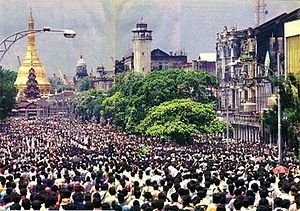
The protests began as a student movement and ended the 26 years rule of Dictator General Ne Win and his totalitarian, one-party socialist government. I wanted to divide my article into two parts, Part 1 - brief political history of Myanmar, formerly called Burma, up to 1988, the things which led to the event and the event itself, and the second part, how it ended, aftermath and how the event changed the political landscape of Myanmar to the present.
Myanmar after end of British Rule
Myanmar, formerly called Burma, is a South East Asian nation bordered by India and Bangladesh to its west, Thailand and Laos to its east and China to its north and northeast. It was once under British colonial rule until got independence in 4th January 1948. It was a democratic republic with multi-party elections, but which was generally characterised by political instability and bitter fighting between parties.
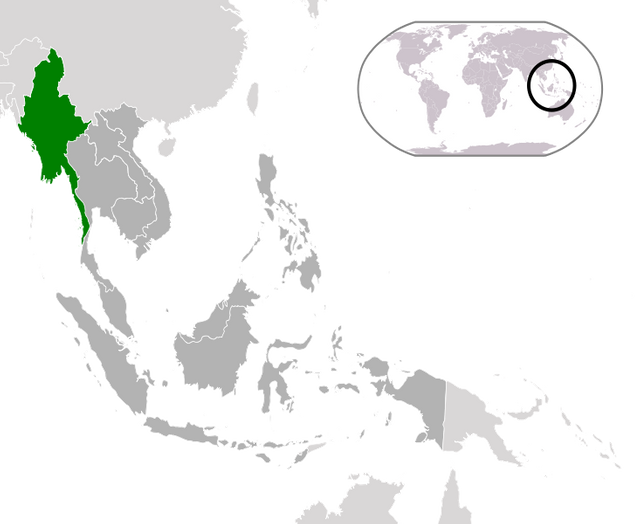
By 1958, the country was largely beginning to recover economically, but was beginning to fall apart politically due to a split of Anti-Fascist People's Freedom League (AFPFL) into two factions. AFPFL was formed to resist Japanese Occupation in WWII and reorganized after war to resist British rule and gain independence. It was also a ruling party since independence. Due to instability and threats from Communism, in 1958, the Army Chief of Staff, General Ne Win, was charged with setting up a caretaker government to restore order, which arrested and deported many ‘communist sympathisers’ and allowed a new general election to take place in 1960. The stability did not last long when a separatist movement started by Shan States and some ethic minorities.
Under the Dictator
General Ne Win staged coup d'état on 2 March 1962 and became head of state as Chairman of the Revolutionary Council, and also Prime Minister. It marked the beginning of totalitarian rule and the political dominance of the army in Myanmar which spanned the course of 26 years. During the period of 1962 to 1974 almost all aspects of society were nationalized or brought under government control. His administration instituted a system that included elements of extreme nationalism, Marxism, and Buddhism and called the ‘Burmese Way to Socialism'. He also founded the Burma Socialist Programme Party (BSPP), and held the position of chairman.
Since it took power in 1962, sporadic protests against the government had broken out several times but were always brutally suppressed. It turned Myanmar, once expected to become one of the fastest developing Asian Tigers of the region, into one of the poorest countries in the world.The country had a national debt of $3.5 billion and currency reserves of between $20 million and $35 million, with debt service ratios standing at half of the national budget.
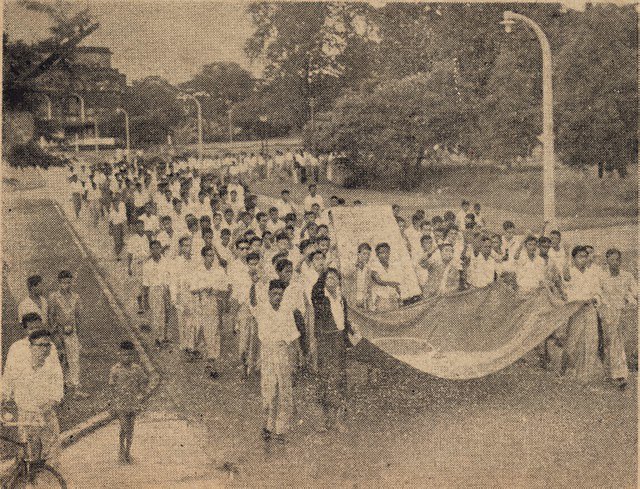
Resentment
Student protests in 1975, 1976, and 1977 were suppressed by overwhelming military force.In November 1985, students gathered and boycotted the government's decision to withdraw Burmese local currency notes, but again in 5 September 1987, Ne Win announced the withdrawal of the newly replaced currency notes. Students were particularly angry at the government's decision as savings for tuition fees were wiped out instantly. University students protested in Yangon, Mandalay and several other cities and towns, and information quickly spread through the students, though State media censored the News. Several, violent rural protests were sparked in December 1987, after government policy requiring farmers to sell produce below market rates to create greater revenue for the government. The country was like a bomb about to explode anytime.
The Spark
On 12 March 1988, students from the Rangoon Institute of Technology (RIT) were arguing with out-of-school youths inside a tea shop about music playing on a sound system. A drunken youth would not return a tape that the RIT students favoured. A brawl followed in which one youth, who was said to be the son of a local government official, was arrested for injuring a student and later released without charges. Students protested at a local police department where 500 riot police were mobilized and in the ensuing clash, one student was shot and killed. The next day more students rallied at the RIT and spread to other campuses. These students had never protested before but now began to see themselves as activists. By mid-March, several protests had occurred and there was open dissent in the army. On 16 March, students demanding an end to one party rule marched towards soldiers at Inya Lake near Yangon University campus, when riot police stormed from the rear, clubbing several students to death and raping others. Several students recalled the police shouting "Don't let them escape" and "Kill them!"
Following the latest protests, authorities announced the closure of universities for several months. By June 1988, large demonstrations of students and sympathisers were a daily sight. Many students, sympathisers and riot police died throughout the month as the protests spread throughout Myanmar. Large scale protests were reported in major cities demanding multi-party democracy. At the height of the uprising, in July 1988, Ne Win resigned as BSPP party chairman. In an address on 23 July 1988 he ominously warned, “When the army shoots, it shoots to kill.” He had appointed the largely disliked Sein Lwin, known as the "Butcher of Rangoon" to head a new government.
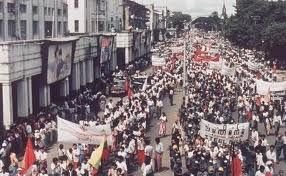
Main Protest
In August of 1988 the protests reached their peak. A nationwide demonstration was planned for 8 August 1988 (8-8-88), an auspicious date based on numerological significance. Between 2 and 10 August, coordinated protests occurred in most Burmese towns, including in rural areas, and Tatmadaw (the Myanmar Armed Force) troops were mobilised. Pamphlets and posters appeared on the streets of Rangoon bearing the fighting peacock insignia of the All-Burma Students Union.
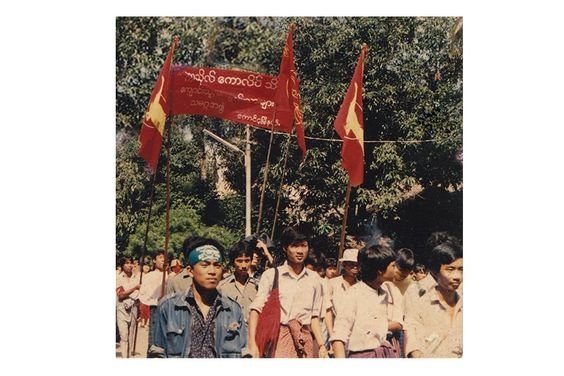
During this period, dissident newspapers were freely publishing, fighting-peacock banners were unfurled, synchronised marches were held and rally speakers were protected. Activists contacted lawyers and monks in Mandalay to encourage them to take part in the protests. The students were quickly joined by a diverse group of Burmese citizens, including government workers, Buddhist monks, military personnel, customs officers, teachers, and hospital staff. 10,000 people alone demonstrated outside the Sule Pagoda in Yangon. On 3 August, the junta imposed martial law and instituted a ban on gatherings of more than five people.
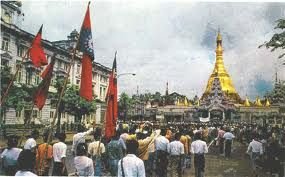
8888
A general strike, as planned, began on 8 August 1988. Mass demonstrations were held across Burma as ethnic minorities, Buddhists, Muslims, students, workers and the young and old all demonstrated. Demonstrators from the Yangon neighborhoods converged in downtown Rangoon. Only one casualty was reported at this point as a frightened traffic policeman fired into the crowd and fled. (Such marches would occur daily until 19 September.) Farmers who were particularly angry with the government's economic policies joined the protests in Rangoon.
Over the next four days these demonstrations continued; the government was surprised by the scale of the protests and stated that it promised to heed the demands of the protesters "insofar as possible". At the same time, brought in more soldiers from insurgent areas to deal with the protesters, and a short while later they opened fire on the protesters. On 10 August soldiers fired into Yangon General Hospital, killing nurses and doctors treating wounded protesters. State-run Radio Rangoon reported that 1,451 “looters and disturbance-makers” had been arrested. Estimates of the number of casualties surrounding the 8-8-88 demonstrations range from hundreds to 10,000 but military authorities put the figures at about 95 people killed and 240 wounded.
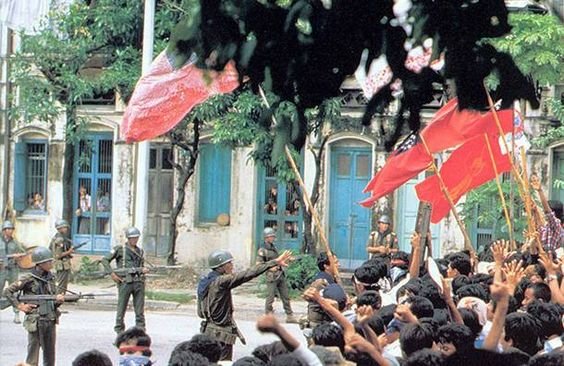
On 12 August Sein Lwin suddenly resigned, an event that left many protestors confused but cheerful. Security forces exercised greater caution with demonstrators and on 19 August, Dr. Maung Maung, a legal scholar and the only non-military person to serve in the BSPP, was appointed as head of the government.
To Be Continue - - -
Congratulations @new-age-myanmar! You have completed the following achievement on Steemit and have been rewarded with new badge(s) :
Click on the badge to view your Board of Honor.
If you no longer want to receive notifications, reply to this comment with the word
STOPsuch a big article
Part - 2 and Final if you interested.
https://steemit.com/politic/@new-age-myanmar/myanmar-s-8888-uprising-and-history-about-it-part-2